
Reported speech - 1
Reported speech - 2
Reported speech - 3
Worksheets - handouts

Reported speech
Worksheets - pdf exercises.
- Reported statements - worksheet
- Worksheet - reported questions
- Reported yes/no questions
- Worksheet - reported speech
- Reported speech - exercises pdf
- Indirect speech - exercises
- Reported speech - exercises
- Mixed reported speech 1
- Mixed reported speech 2
- Reported speech 1
- Reported speech 2
- Reported speech 3
- Reported speech 4
- Reported speech 5
- Reported wh- questions
- Reported speech - worksheet
- Reported commands
- Reported questions
- Reported speech 1
- Reported speech 2
- Reported requests and orders
- Reported speech exercise
- Reported questions - worksheet
- Indirect speech - worksheet
- Worksheets pdf - print
- Grammar worksheets - handouts
Grammar - lessons
- Reported speech - grammar notes
- How to use reported speech - lesson
- Tense changes - grammar
Reported Speech
Perfect english grammar.

Reported Statements
Here's how it works:
We use a 'reporting verb' like 'say' or 'tell'. ( Click here for more about using 'say' and 'tell' .) If this verb is in the present tense, it's easy. We just put 'she says' and then the sentence:
- Direct speech: I like ice cream.
- Reported speech: She says (that) she likes ice cream.
We don't need to change the tense, though probably we do need to change the 'person' from 'I' to 'she', for example. We also may need to change words like 'my' and 'your'. (As I'm sure you know, often, we can choose if we want to use 'that' or not in English. I've put it in brackets () to show that it's optional. It's exactly the same if you use 'that' or if you don't use 'that'.)
But , if the reporting verb is in the past tense, then usually we change the tenses in the reported speech:
- Reported speech: She said (that) she liked ice cream.
* doesn't change.
- Direct speech: The sky is blue.
- Reported speech: She said (that) the sky is/was blue.
Click here for a mixed tense exercise about practise reported statements. Click here for a list of all the reported speech exercises.
Reported Questions
So now you have no problem with making reported speech from positive and negative sentences. But how about questions?
- Direct speech: Where do you live?
- Reported speech: She asked me where I lived.
- Direct speech: Where is Julie?
- Reported speech: She asked me where Julie was.
- Direct speech: Do you like chocolate?
- Reported speech: She asked me if I liked chocolate.
Click here to practise reported 'wh' questions. Click here to practise reported 'yes / no' questions. Reported Requests
There's more! What if someone asks you to do something (in a polite way)? For example:
- Direct speech: Close the window, please
- Or: Could you close the window please?
- Or: Would you mind closing the window please?
- Reported speech: She asked me to close the window.
- Direct speech: Please don't be late.
- Reported speech: She asked us not to be late.
Reported Orders
- Direct speech: Sit down!
- Reported speech: She told me to sit down.
- Click here for an exercise to practise reported requests and orders.
- Click here for an exercise about using 'say' and 'tell'.
- Click here for a list of all the reported speech exercises.

Hello! I'm Seonaid! I'm here to help you understand grammar and speak correct, fluent English.
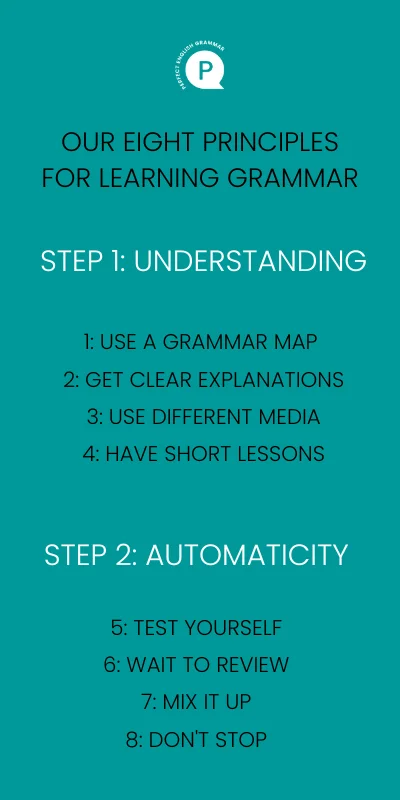
Read more about our learning method

Reported Speech with Examples and Test (PDF)
Reported speech is used when we want to convey what someone else has said to us or to another person. It involves paraphrasing or summarising what has been said , often changing verb tenses , pronouns and other elements to suit the context of the report.
*doesn’t change
Formula of Reported Speech
The formula for reported speech involves transforming direct speech into an indirect form while maintaining the meaning of the original statement. In general, the formula includes:
- Choosing an appropriate reporting verb (e.g., say, tell, mention, explain).
- Changing pronouns and time expressions if necessary.
- Shifting the tense of the verb back if the reporting verb is in the past tense.
- Using reporting clauses like “that” or appropriate conjunctions.
- Adjusting word order and punctuation to fit the structure of the reported speech.
Here’s a simplified formula:
Reporting Verb + Indirect Object + Conjunction + Reported Clause
For example:
- She said (reporting verb) to me (indirect object) that (conjunction) she liked ice cream (reported clause).
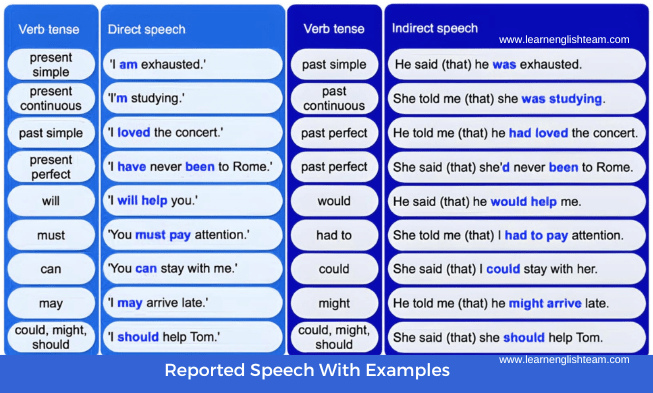
Here’s how we use reported speech:
Reporting Verbs: We use verbs like ‘say’ or ‘tell’ to introduce reported speech. If the reporting verb is in the present tense, the tense of the reported speech generally remains the same.
If the reporting verb is in the past tense , the tense of the reported speech often shifts back in time.
Tense Changes: Tense changes are common in reported speech. For example, present simple may change to past simple, present continuous to past continuous, etc. However, some verbs like ‘would’, ‘could’, ‘should’, ‘might’, ‘must’, and ‘ought to’ generally don’t change.
Reported Questions: When reporting questions, we often change them into statements while preserving the meaning. Question words are retained, and the tense of the verbs may change.
Reported Requests and Orders: Requests and orders are reported similarly to statements. Reported requests often use ‘asked me to’ + infinitive, while reported orders use ‘told me to’ + infinitive.
Time Expressions: Time expressions may need to change depending on when the reported speech occurred in relation to the reporting moment. For instance, ‘today’ may become ‘that day’ or ‘yesterday’, ‘yesterday’ might become ‘the day before’, and so forth.
Reported Speech with Examples PDF
Reported Speech PDF – download
Reported Speech Test
Reported Speech A2 – B1 Test – download
You May Also Like

Future Tense Exercise Short Stories
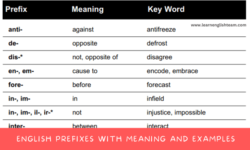
English Prefixes with Meaning and Examples (PDF)
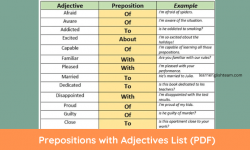
Prepositions with Adjectives List (PDF)
- I would like books for studying.
- Types of Verbs
- Types of Adjectives
- Types of Noun
- Participles
- Phrases and Clauses
- Parts of Speech
- Parts of a Sentence
- Determiners
- Parallelism
- Direct & Indirect Speech
- Modal Verbs
- Relative Clauses
- Nominalisation
- Substitution & Ellipsis
- Demonstratives
- Pronoun Reference
- Confusing Words
- Online Grammar Quizzes
- Printable Grammar Worksheets
- Courses to purchase
- Grammar Book
- Grammar Blog
- Direct & Indirect Speech
Reported Speech Tenses
Reported speech tenses will change from that of the direct speech in most cases.
This is known as backshifting in reported speech , with the basic rule that a tense is shifted back to its past tense form.
This is because we are usually talking about something in the past.
You can also watch a video of this lesson:

Backshifting in Reported Speech
Here are some examples of backshifting, with tenses going back from present to past:
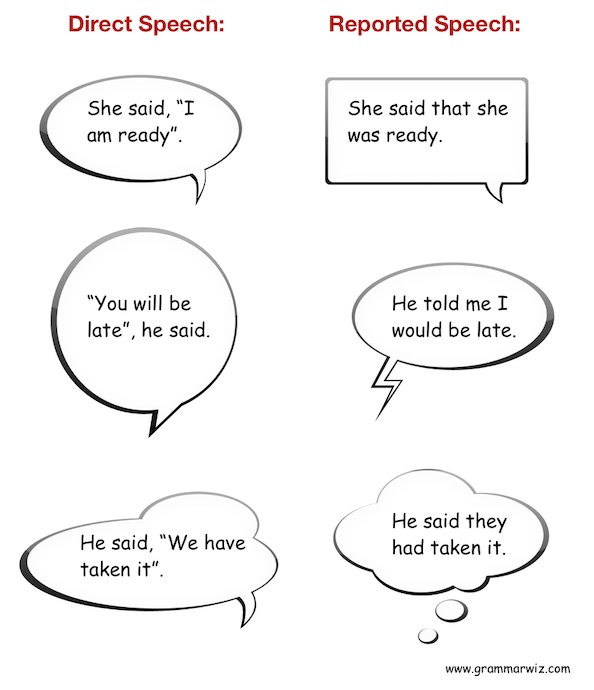
Reported Speech Tenses Change Chart
Below is a reported speech tense change chart with the rules for backshifting for each tense and for modal verbs.
You will see reported speech does not go back a tense if it is already in the past perfect (there is no further back it can go), and some modal verbs also do not change.
If you are tested on this, though, these are the changes you need to make.
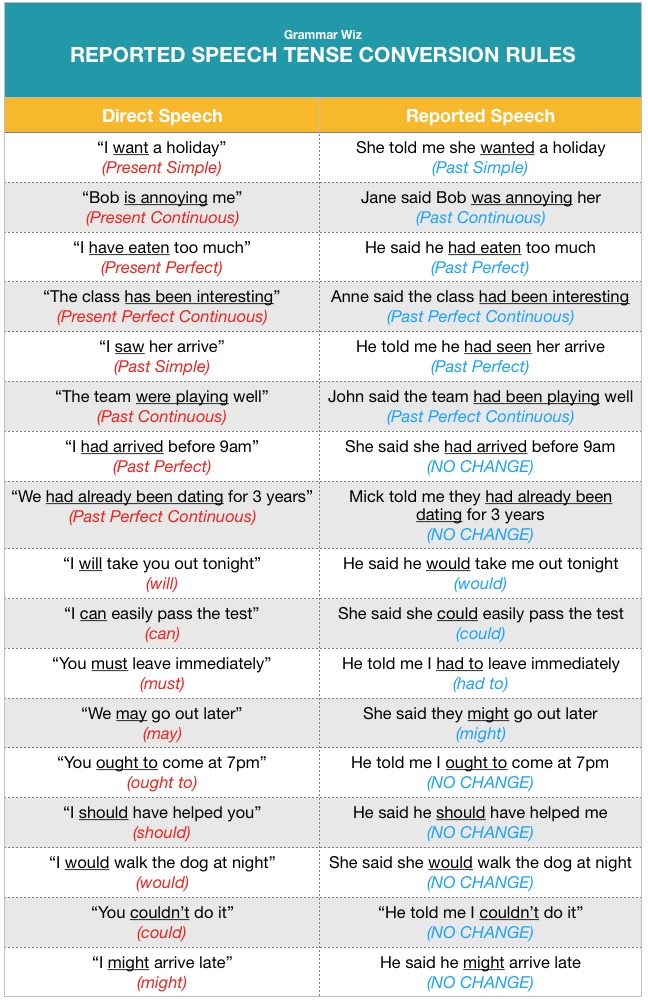
Exceptions to the rules
This is a useful starting point. However, it is a simplification as we may not always decide or need to shift the tense back.
For instance, if the circumstances we are reporting on have not changed since they were directly said, then the tense would not need to be changed. For example:
Direct Speech
- I am happy
- (present simple)
Reported Speech
- She said she is happy
So if we want to convey that the situation is still true then we may keep the tense the same.
Alternatively, the tense could even forward shift. An example would be in relation to a film or book. In this case, the person may use the past tense to say that the film was good, but the present or past tense could be used when you convey that to someone else:
Direct Speech:
- The film was really good!
- (past simple)
Reported Speech:
- He said that the film was very good!
- (past simple) Or
- He said that the film is very good!
As you can see, either reported speech tenses would be ok if you wanted to pass the information on to somebody else. The person said the film was good, and it is still good (it hasn't gone away).
So there are some general rules for reported speech tense changes but it can depend on the context. There may be no need to change it or you may be able to choose either tense.
Click the ' reported speech: practice forming indirect speech ' link below to practice changing tenses.
More on Reported Speech:
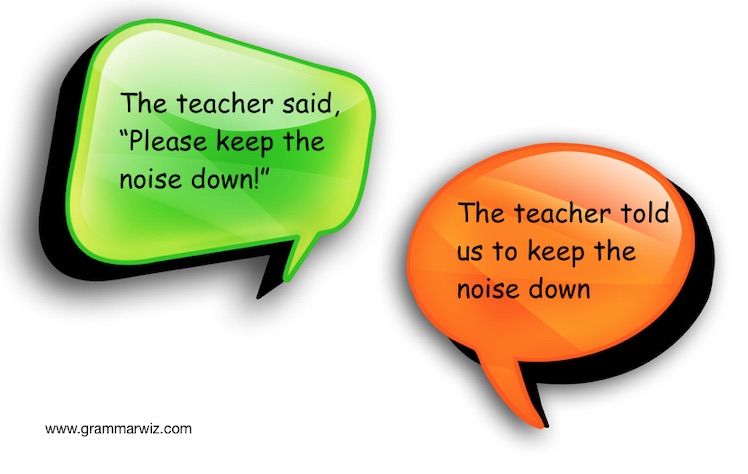
Reported Speech Imperatives: Reporting commands in indirect speech
Reported speech imperatives, also known as reported commands, follow a slightly different structure to normal indirect speech. We use imperatives to give orders, advice, or make requests.
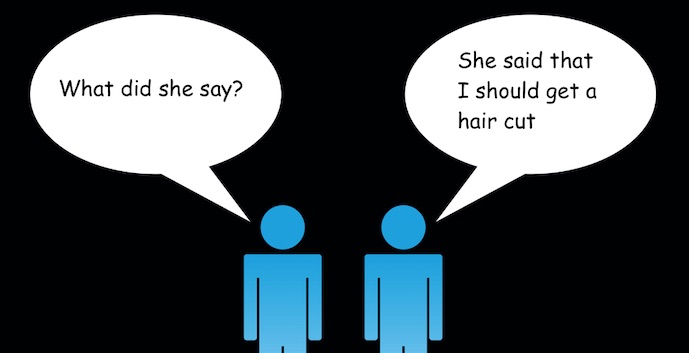
Direct and Indirect Speech: The differences explained
Direct and indirect speech are different because in direct speech the exact words said are spoken, but in indirect or reported speech, we are reporting what was said, usually using the past tense.

Reported Speech Quiz - Practice forming indirect speech
This reported speech quiz gives you the chance to practice converting direct speech to reported speech, also known as indirect speech. This involves backshifting with the tenses.

Examples of Direct and Indirect Speech
In these examples of direct and indirect speech you are given a sentence in direct speech which is then connected to indirect speech.
Sign up for free grammar tips, quizzes and lessons, straight into your inbox
New! Comments
Any questions or comments about the grammar discussed on this page?
Post your comment here.

Grammar Rules
Subscribe to grammar wiz:, grammar ebook.

This is an affiliate link
Recent Articles
Zero Article Rules with Examples
Apr 13, 24 02:33 AM
Definite, Indefinite and Zero Articles Explained
Apr 05, 24 09:40 AM
Definite and Indefinite Articles Quiz
Mar 30, 24 12:58 PM
Important Pages
Online Quizzes Courses Blog
Connect with Us
Search Site
Privacy Policy / Disclaimer / Terms of Use
English Practice Downloadable PDF Grammar and Vocabulary Worksheets
Reported speech (b1).
- RS013 - Reported Speech
- RS012 - Reported Questions and Commands
- RS011 - Reported Speech
- RS010 - Reported Speech
- RS009 - Reported Commands
- RS008 - Reported Questions
- RS007 - Reported Speech
- RS006 - Reported Speech
- RS005 - Reported Speech
- RS004 - Reported Speech
- RS003 - Reported Speech
- RS002 - Reported Speech - Mixed Exercises
- RS001 - Reported Speech - Mixed Exercises
- Adjective - Adverb
- Gerund and Infinitive
- Modal Verbs
- Reported Speech
- Passive Voice
- Definite and Indefinite Articles
- Quantifiers
- Relative Clauses
- Prepositions
- Questions and Negations
- Question Tags
- Language in Use
- Word Formation
- General Vocabulary
- Topical Vocabulary
- Key Word Transformation
News Articles
- Letters and Emails
- Blog Posts and Comments
- Connectives and Linking Phrases
- Phrasal Verbs
- Collocations and Phrases
Listening Comprehension
Privacy policy.

Reported Speech: Rules, Examples, Exceptions

👉 Quiz 1 / Quiz 2
Advanced Grammar Course
What is reported speech?
“Reported speech” is when we talk about what somebody else said – for example:
- Direct Speech: “I’ve been to London three times.”
- Reported Speech: She said she’d been to London three times.
There are a lot of tricky little details to remember, but don’t worry, I’ll explain them and we’ll see lots of examples. The lesson will have three parts – we’ll start by looking at statements in reported speech, and then we’ll learn about some exceptions to the rules, and finally we’ll cover reported questions, requests, and commands.

So much of English grammar – like this topic, reported speech – can be confusing, hard to understand, and even harder to use correctly. I can help you learn grammar easily and use it confidently inside my Advanced English Grammar Course.
In this course, I will make even the most difficult parts of English grammar clear to you – and there are lots of opportunities for you to practice!

Backshift of Verb Tenses in Reported Speech
When we use reported speech, we often change the verb tense backwards in time. This can be called “backshift.”
Here are some examples in different verb tenses:
Reported Speech (Part 1) Quiz
Exceptions to backshift in reported speech.
Now that you know some of the reported speech rules about backshift, let’s learn some exceptions.
There are two situations in which we do NOT need to change the verb tense.
No backshift needed when the situation is still true
For example, if someone says “I have three children” (direct speech) then we would say “He said he has three children” because the situation continues to be true.
If I tell you “I live in the United States” (direct speech) then you could tell someone else “She said she lives in the United States” (that’s reported speech) because it is still true.
When the situation is still true, then we don’t need to backshift the verb.

He said he HAS three children
But when the situation is NOT still true, then we DO need to backshift the verb.
Imagine your friend says, “I have a headache.”
- If you immediately go and talk to another friend, you could say, “She said she has a headache,” because the situation is still true
- If you’re talking about that conversation a month after it happened, then you would say, “She said she had a headache,” because it’s no longer true.
No backshift needed when the situation is still in the future
We also don’t need to backshift to the verb when somebody said something about the future, and the event is still in the future.
Here’s an example:
- On Monday, my friend said, “I ‘ll call you on Friday .”
- “She said she ‘ll call me on Friday”, because Friday is still in the future from now.
- It is also possible to say, “She said she ‘d (she would) call me on Friday.”
- Both of them are correct, so the backshift in this case is optional.
Let’s look at a different situation:
- On Monday, my friend said, “I ‘ll call you on Tuesday .”
- “She said she ‘d call me on Tuesday.” I must backshift because the event is NOT still in the future.
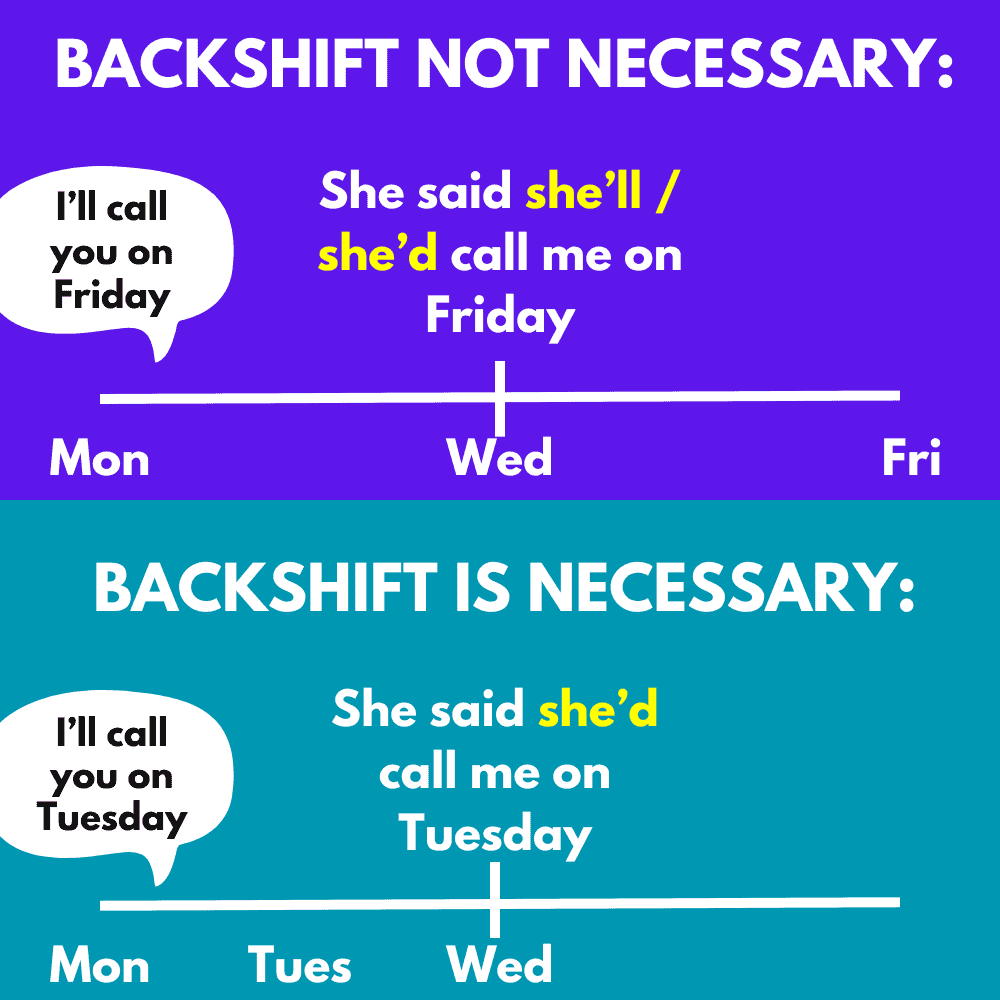
Review: Reported Speech, Backshift, & Exceptions
Quick review:
- Normally in reported speech we backshift the verb, we put it in a verb tense that’s a little bit further in the past.
- when the situation is still true
- when the situation is still in the future
Reported Requests, Orders, and Questions
Those were the rules for reported statements, just regular sentences.
What about reported speech for questions, requests, and orders?
For reported requests, we use “asked (someone) to do something”:
- “Please make a copy of this report.” (direct speech)
- She asked me to make a copy of the report. (reported speech)
For reported orders, we use “told (someone) to do something:”
- “Go to the bank.” (direct speech)
- “He told me to go to the bank.” (reported speech)
The main verb stays in the infinitive with “to”:
- She asked me to make a copy of the report. She asked me make a copy of the report.
- He told me to go to the bank. He told me go to the bank.
For yes/no questions, we use “asked if” and “wanted to know if” in reported speech.
- “Are you coming to the party?” (direct)
- He asked if I was coming to the party. (reported)
- “Did you turn off the TV?” (direct)
- She wanted to know if I had turned off the TV.” (reported)
The main verb changes and back shifts according to the rules and exceptions we learned earlier.
Notice that we don’t use do/does/did in the reported question:
- She wanted to know did I turn off the TV.
- She wanted to know if I had turned off the TV.
For other questions that are not yes/no questions, we use asked/wanted to know (without “if”):
- “When was the company founded?” (direct)
- She asked when the company was founded.” (reported)
- “What kind of car do you drive?” (direct)
- He wanted to know what kind of car I drive. (reported)
Again, notice that we don’t use do/does/did in reported questions:
- “Where does he work?”
- She wanted to know where does he work.
- She wanted to know where he works.
Also, in questions with the verb “to be,” the word order changes in the reported question:
- “Where were you born?” ([to be] + subject)
- He asked where I was born. (subject + [to be])
- He asked where was I born.
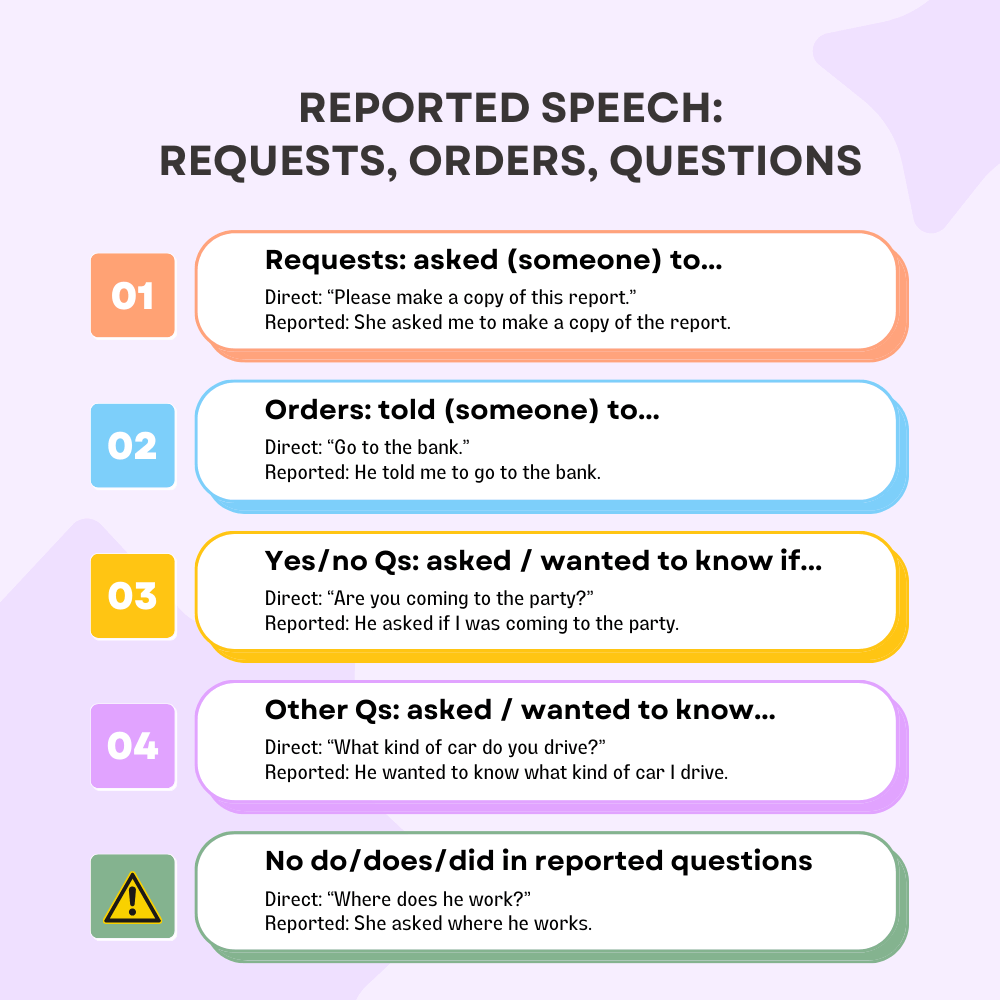
Reported Speech (Part 2) Quiz
Learn more about reported speech:
- Reported speech: Perfect English Grammar
- Reported speech: BJYU’s
If you want to take your English grammar to the next level, then my Advanced English Grammar Course is for you! It will help you master the details of the English language, with clear explanations of essential grammar topics, and lots of practice. I hope to see you inside!
I’ve got one last little exercise for you, and that is to write sentences using reported speech. Think about a conversation you’ve had in the past, and write about it – let’s see you put this into practice right away.
Master the details of English grammar:

More Espresso English Lessons:
About the author.
Shayna Oliveira
Shayna Oliveira is the founder of Espresso English, where you can improve your English fast - even if you don’t have much time to study. Millions of students are learning English from her clear, friendly, and practical lessons! Shayna is a CELTA-certified teacher with 10+ years of experience helping English learners become more fluent in her English courses.
Time and Place in Reported Speech
When we report something, we may need to make changes to:
- time (now, tomorrow)
- place (here, this room)
If we report something around the same time, then we probably do not need to make any changes to time words . But if we report something at a different time, we need to change time words. Look at these example sentences:
- He said: "It was hot yesterday ." → He said that it had been hot the day before .
- He said: "We are going to swim tomorrow ." → He said they were going to swim the next day .
Here is a list of common time words, showing how you change them for reported speech:
Place words
If we are in the same place when we report something, then we do not need to make any changes to place words . But if we are in a different place when we report something, then we need to change the place words. Look at these example sentences:
- He said: "It is cold in here ." → He said that it was cold in there .
- He said: "How much is this book ?" → He asked how much the book was.
Here are some common place words, showing how you change them for reported speech:
Contributor: Josef Essberger
- English Grammar
- Reported Speech
Reported Speech - Definition, Rules and Usage with Examples
Reported speech or indirect speech is the form of speech used to convey what was said by someone at some point of time. This article will help you with all that you need to know about reported speech, its meaning, definition, how and when to use them along with examples. Furthermore, try out the practice questions given to check how far you have understood the topic.

Table of Contents
Definition of reported speech, rules to be followed when using reported speech, table 1 – change of pronouns, table 2 – change of adverbs of place and adverbs of time, table 3 – change of tense, table 4 – change of modal verbs, tips to practise reported speech, examples of reported speech, check your understanding of reported speech, frequently asked questions on reported speech in english, what is reported speech.
Reported speech is the form in which one can convey a message said by oneself or someone else, mostly in the past. It can also be said to be the third person view of what someone has said. In this form of speech, you need not use quotation marks as you are not quoting the exact words spoken by the speaker, but just conveying the message.
Now, take a look at the following dictionary definitions for a clearer idea of what it is.
Reported speech, according to the Oxford Learner’s Dictionary, is defined as “a report of what somebody has said that does not use their exact words.” The Collins Dictionary defines reported speech as “speech which tells you what someone said, but does not use the person’s actual words.” According to the Cambridge Dictionary, reported speech is defined as “the act of reporting something that was said, but not using exactly the same words.” The Macmillan Dictionary defines reported speech as “the words that you use to report what someone else has said.”
Reported speech is a little different from direct speech . As it has been discussed already, reported speech is used to tell what someone said and does not use the exact words of the speaker. Take a look at the following rules so that you can make use of reported speech effectively.
- The first thing you have to keep in mind is that you need not use any quotation marks as you are not using the exact words of the speaker.
- You can use the following formula to construct a sentence in the reported speech.
- You can use verbs like said, asked, requested, ordered, complained, exclaimed, screamed, told, etc. If you are just reporting a declarative sentence , you can use verbs like told, said, etc. followed by ‘that’ and end the sentence with a full stop . When you are reporting interrogative sentences, you can use the verbs – enquired, inquired, asked, etc. and remove the question mark . In case you are reporting imperative sentences , you can use verbs like requested, commanded, pleaded, ordered, etc. If you are reporting exclamatory sentences , you can use the verb exclaimed and remove the exclamation mark . Remember that the structure of the sentences also changes accordingly.
- Furthermore, keep in mind that the sentence structure , tense , pronouns , modal verbs , some specific adverbs of place and adverbs of time change when a sentence is transformed into indirect/reported speech.
Transforming Direct Speech into Reported Speech
As discussed earlier, when transforming a sentence from direct speech into reported speech, you will have to change the pronouns, tense and adverbs of time and place used by the speaker. Let us look at the following tables to see how they work.
Here are some tips you can follow to become a pro in using reported speech.
- Select a play, a drama or a short story with dialogues and try transforming the sentences in direct speech into reported speech.
- Write about an incident or speak about a day in your life using reported speech.
- Develop a story by following prompts or on your own using reported speech.
Given below are a few examples to show you how reported speech can be written. Check them out.
- Santana said that she would be auditioning for the lead role in Funny Girl.
- Blaine requested us to help him with the algebraic equations.
- Karishma asked me if I knew where her car keys were.
- The judges announced that the Warblers were the winners of the annual acapella competition.
- Binsha assured that she would reach Bangalore by 8 p.m.
- Kumar said that he had gone to the doctor the previous day.
- Lakshmi asked Teena if she would accompany her to the railway station.
- Jibin told me that he would help me out after lunch.
- The police ordered everyone to leave from the bus stop immediately.
- Rahul said that he was drawing a caricature.
Transform the following sentences into reported speech by making the necessary changes.
1. Rachel said, “I have an interview tomorrow.”
2. Mahesh said, “What is he doing?”
3. Sherly said, “My daughter is playing the lead role in the skit.”
4. Dinesh said, “It is a wonderful movie!”
5. Suresh said, “My son is getting married next month.”
6. Preetha said, “Can you please help me with the invitations?”
7. Anna said, “I look forward to meeting you.”
8. The teacher said, “Make sure you complete the homework before tomorrow.”
9. Sylvester said, “I am not going to cry anymore.”
10. Jade said, “My sister is moving to Los Angeles.”
Now, find out if you have answered all of them correctly.
1. Rachel said that she had an interview the next day.
2. Mahesh asked what he was doing.
3. Sherly said that her daughter was playing the lead role in the skit.
4. Dinesh exclaimed that it was a wonderful movie.
5. Suresh said that his son was getting married the following month.
6. Preetha asked if I could help her with the invitations.
7. Anna said that she looked forward to meeting me.
8. The teacher told us to make sure we completed the homework before the next day.
9. Sylvester said that he was not going to cry anymore.
10. Jade said that his sister was moving to Los Angeles.
What is reported speech?
What is the definition of reported speech.
Reported speech, according to the Oxford Learner’s Dictionary, is defined as “a report of what somebody has said that does not use their exact words.” The Collins Dictionary defines reported speech as “speech which tells you what someone said, but does not use the person’s actual words.” According to the Cambridge Dictionary, reported speech is defined as “the act of reporting something that was said, but not using exactly the same words.” The Macmillan Dictionary defines reported speech as “the words that you use to report what someone else has said.”
What is the formula of reported speech?
You can use the following formula to construct a sentence in the reported speech. Subject said that (report whatever the speaker said)
Give some examples of reported speech.
Given below are a few examples to show you how reported speech can be written.
Leave a Comment Cancel reply
Your Mobile number and Email id will not be published. Required fields are marked *
Request OTP on Voice Call
Post My Comment
- Share Share
Register with BYJU'S & Download Free PDFs
Register with byju's & watch live videos.

Reported Speech Spanish Guide: Examples + Verb Changes
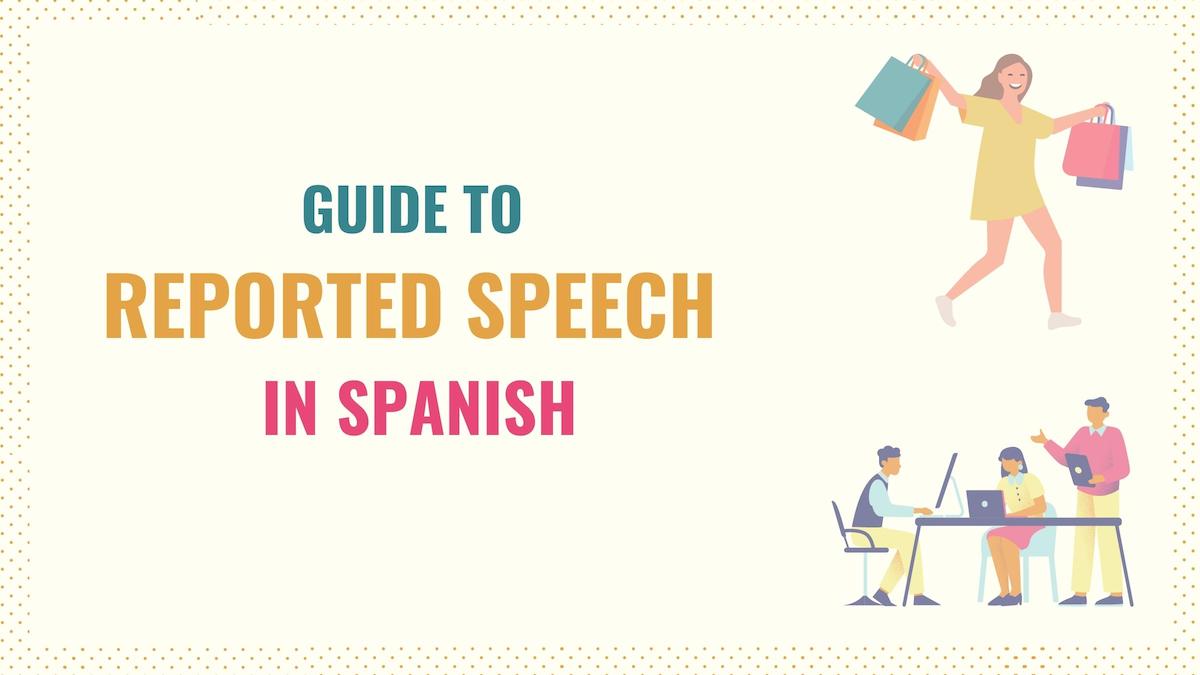
Reported speech is an overlooked yet crucial feature in everyday conversations. In short, it allows you to convey what someone else said adequately. Since mastering this topic can boost your fluency, in this reported speech Spanish guide, you’ll learn:
- How to form reported speech
- Verb Changes in Indirect Speech
- Downloadable PDF
In addition to this, I’ve also included different examples of how to apply this concept in real-life situations. Let’s do this!
What Is the Reported Speech in Spanish?
Reported speech in Spanish, also known as indirect speech, conveys what someone else said without quoting their exact words.
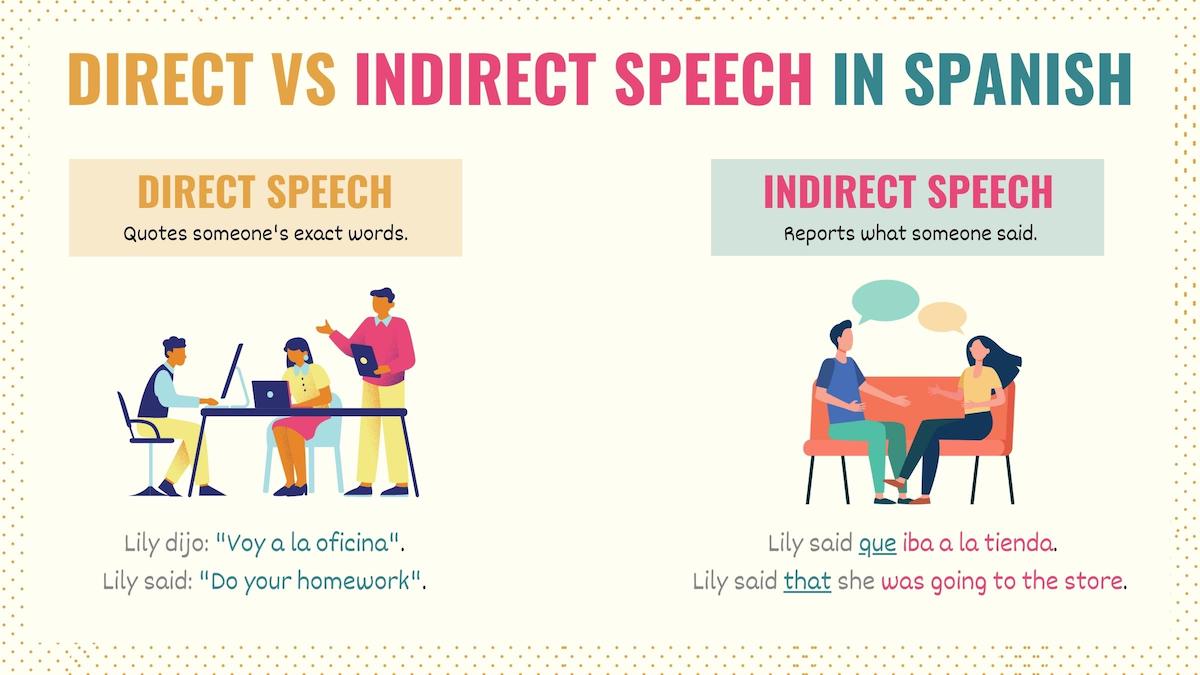
Simply put, Spanish indirect speech allows you to rephrase and report what someone said. On the contrary, direct speech involves quoting the exact words a person used. For instance:
In Spanish, decir is the most common verb to form the reported speech. However, you can also use the following verbs:
- Aclarar : Clarify / Explain
- Afirmar : Affirm / Clair
- Anunciar : Announce
- Contar : Tell
- Explicar : Explain
- Pedir : Ask
- Preguntar : Ask
- Prometer : Promise
- Recordar : Remember
- Recomendar : Recommend
- Sugerir : Suggest
Spanish indirect speech allows you to share information and someone’s thoughts or opinions with different people. As a result, it’s commonly used in news and writing environments, but also in daily conversations.
How to form indirect speech
To report what someone said, we use one of the previous verbs followed by que:
[Verb] + que + [statement]
When using reported speech in Spanish you’re repeating what another person said, we must do some modifications to preserve the meaning of the original sentence. These changes include:
- Adjust the pronouns and adjectives
- Change the verb tense (if applicable)
Take this graphic as an example:
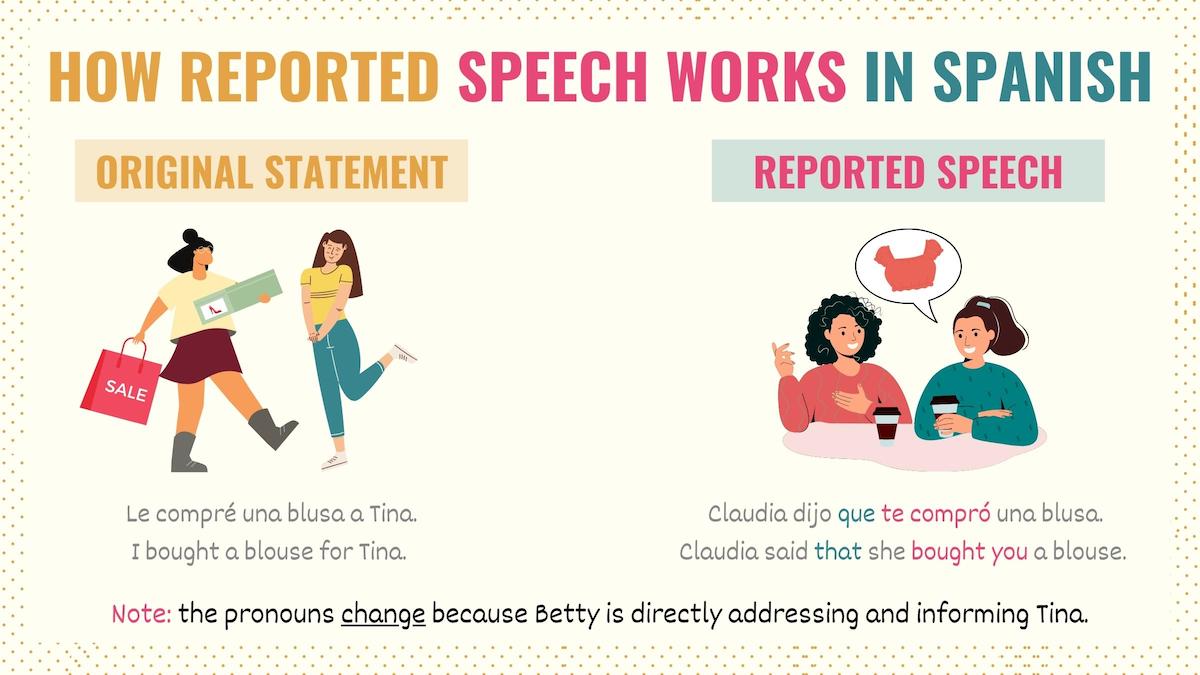
Spanish Reported Speech: Verb Backshifting
When it comes to reported speech, verb conjugations are one of the major adjustments you must make. In simple words, we must change the tense of the original verb to maintain a logical sequence. In Spanish grammar , this is known as backshifting .
To help you understand and apply backshifting in reported speech, I’ve prepared this table that compares the original tenses with their backshifted equivalents:
We only change the tense of a verb when the original action already took place . Let me break this down for you.
Let’s say you’re traveling and you call me today to tell me when you arrive. You’ll say:
Llegaré a las dos. I will arrive at two.
But the time comes, and you’re not here. Everybody is asking me what time you’re supposed to arrive and I repeat what you said:
Me dijo que llegaría a las 2. He said he would arrive at 2.
In this case, I backshifted the verb because the original action (arrival time) had already passed. The same happens with other tenses.
However, the tense of the original statement doesn’t change when talking about facts or when the action is still relevant (it just happened).
Take this sentence as an example:
This example implies that I’m immediately telling you what our friend said.
Reported Speech: Additional Spanish Resources
Transforming from direct and indirect speech requires knowledge of diverse grammatical elements. For starters, you must have a good command of Spanish pronouns so you know which pronoun to use for your sentence.
On that same note, you should also get familiar with possessive adjectives in case you need to mention someone’s belongings. And, of course, you must be comfortable conjugating verbs in different Spanish tenses .
Make sure you know how to form the:
- Present indicative
- Present perfect
- Present subjunctive
- Preterite tense
- Imperfect subjunctive
- Past perfect
- Imperative
- Future simple
- Conditional tense
Download the Spanish Reported Speech PDF
Download a free PDF made for this guide including the graphics for reported speech as well as the backshifting verbs table so you can learn how to convert direct into indirect speech.
Daniela Sanchez
¡Hola! Soy Daniela Sanchez, I've been studying Spanish professionally as well as teaching it in Mexico and online for over 10 years. I’ve taught Spanish to a wide array of foreigners from many backgrounds. Over the years, I've made it my mission to work hard on refining many challenging to understand grammar topics to make my students' learning experiences easier, faster and more enjoyable. Read More About Me
Recent Posts
Verbs Like Gustar in Spanish: Conjugations + Must-Know List
Gustar and verbs like gustar convey the feelings and emotions that the subject provokes on someone or something. Their key differentiator is that they inverse the sentence order. Unlike most...
Muy vs Mucho: Key Differences Explained (+ Examples)
Muy means ‘very’. It intensifies the qualities described by an adjective or another adverb. Mucho is the equivalent of ‘a lot’ or ‘very much’, and it conveys the intensity or degree of an...
Pin It on Pinterest
What caused Dubai floods? Experts cite climate change, not cloud seeding
- Medium Text
DID CLOUD SEEDING CAUSE THE STORM?

CAN'T CREATE CLOUDS FROM NOTHING
Sign up here.
Reporting by Alexander Cornwell; editing by Maha El Dahan and Alexandra Hudson
Our Standards: The Thomson Reuters Trust Principles. New Tab , opens new tab

World Chevron

Israel's Netanyahu says 'more has to be done' to stop pro-Palestinian protests on US campuses
Israeli Prime Minister Benjamin Netanyahu said on Wednesday "more has to be done" to stop pro-Palestinian protests that have spread across U.S. campuses in recent weeks.

- Share full article
Advertisement
Supported by
Biden Administration Releases Revised Title IX Rules
The new regulations extended legal protections to L.G.B.T.Q. students and rolled back several policies set under the Trump administration.

By Zach Montague and Erica L. Green
Reporting from Washington
The Biden administration issued new rules on Friday cementing protections for L.G.B.T.Q. students under federal law and reversing a number of Trump-era policies that dictated how schools should respond to cases of alleged sexual misconduct in K-12 schools and college campuses.
The new rules, which take effect on Aug. 1, effectively broadened the scope of Title IX, the 1972 law prohibiting sex discrimination in educational programs that receive federal funding. They extend the law’s reach to prohibit discrimination and harassment based on sexual orientation and gender identity, and widen the range of sexual harassment complaints that schools will be responsible for investigating.
“These regulations make it crystal clear that everyone can access schools that are safe, welcoming and that respect their rights,” Miguel A. Cardona, the education secretary, said in a call with reporters.
The rules deliver on a key campaign promise for Mr. Biden, who declared he would put a “quick end” to the Trump-era Title IX rules and faced mounting pressure from Democrats and civil rights leaders to do so.
The release of the updated rules, after two delays, came as Mr. Biden is in the thick of his re-election bid and is trying to galvanize key electoral constituencies.
Through the new regulations, the administration moved to include students in its interpretation of Bostock v. Clayton County, the landmark 2020 Supreme Court case in which the court ruled that the Civil Rights Act of 1964 protects gay and transgender workers from workplace discrimination. The Trump administration held that transgender students were not protected under federal laws, including after the Bostock ruling .
In a statement, Betsy DeVos, who served as Mr. Trump’s education secretary, criticized what she called a “radical rewrite” of the law, asserting that it was an “endeavor born entirely of progressive politics, not sound policy.”
Ms. DeVos said the inclusion of transgender students in the law gutted decades of protections and opportunities for women. She added that the Biden administration also “seeks to U-turn to the bad old days where sexual misconduct was sent to campus kangaroo courts, not resolved in a way that actually sought justice.”
While the regulations released on Friday contained considerably stronger protections for L.G.B.T.Q. students, the administration steered clear of the lightning-rod issue of whether transgender students should be able to play on school sports teams corresponding to their gender identity.
The administration stressed that while, writ large, exclusion based on gender identity violated Title IX, the new regulations did not extend to single-sex living facilities or sports teams. The Education Department is pursuing a second rule dealing with sex-related eligibility for male and female sports teams. The rule-making process has drawn more than 150,000 comments.
Under the revisions announced on Friday, instances where transgender students are subjected to a “hostile environment” through bullying or harassment, or face unequal treatment and exclusion in programs or facilities based on their gender identity, could trigger an investigation by the department’s Office for Civil Rights.
Instances where students are repeatedly referred to by a name or pronoun other than one they have chosen could also be considered harassment on a case-by-case basis.
“This is a bold and important statement that transgender and nonbinary students belong, in their schools and in their communities,” said Olivia Hunt, the policy director for the National Center for Transgender Equality.
The regulations appeared certain to draw to legal challenges from conservative groups.
May Mailman, the director of the Independent Women’s Law Center, said in a statement that the group planned to sue the administration. She said it was clear that the statute barring discrimination on the basis of “sex” means “binary and biological.”
“The unlawful omnibus regulation reimagines Title IX to permit the invasion of women’s spaces and the reduction of women’s rights in the name of elevating protections for ‘gender identity,’ which is contrary to the text and purpose of Title IX,” she said.
The existing rules, which took effect under Mr. Trump in 2020, were the first time that sexual assault provisions were codified under Title IX. They bolstered due process rights of accused students, relieved schools of some legal liabilities and laid out rigid parameters for how schools should conduct impartial investigations.
They were a sharp departure from the Obama administration’s interpretation of the law, which came in the form of unenforceable guidance documents directing schools to ramp up investigations into sexual assault complaints under the threat of losing federal funding. Scores of students who had been accused of sexual assault went on to win court cases against their colleges for violating their due process rights under the guidelines.
The Biden administration’s rules struck a balance between the Obama and Trump administration’s goals. Taken together, the regulation largely provides more flexibility for how schools conduct investigations, which advocates and schools have long lobbied for.
Catherine E. Lhamon, the head of the department’s Office for Civil Rights who also held the job under President Barack Obama, called the new rules the “most comprehensive coverage under Title IX since the regulations were first promulgated in 1975.”
They replaced a narrower definition of sex-based harassment adopted under the Trump administration with one that would include a wider range of conduct. And they reversed a requirement that schools investigate only incidents alleged to have occurred on their campuses or in their programs.
Still, some key provisions in the Trump-era rules were preserved, including one allowing informal resolutions and another prohibiting penalties against students until after an investigation.
Among the most anticipated changes was the undoing of a provision that required in-person, or so-called live hearings, in which students accused of sexual misconduct, or their lawyers, could confront and question accusers in a courtroom-like setting.
The new rules allow in-person hearings, but do not mandate them. They also require a process through which a decision maker could assess a party or witness’s credibility, including posing questions from the opposing party.
“The new regulations put an end to unfair and traumatic grievance procedures that favor harassers,” Kel O’Hara, a senior attorney at Equal Rights Advocates. “No longer will student survivors be subjected to processes that prioritize the interests of their perpetrators over their own well being and safety.”
The new rules also allow room for schools to use a “preponderance of evidence” standard, a lower burden of proof than the DeVos-era rules encouraged, through which administrators need only to determine whether it was more likely than not that sexual misconduct had occurred.
The renewed push for that standard drew criticism from legal groups who said the rule stripped away hard-won protections against flawed findings.
“When you are dealing with accusations of really one of the most heinous crimes that a person can commit — sexual assault — it’s not enough to say, ‘50 percent and a feather,’ before you brand someone guilty of this repulsive crime,” said Will Creeley, the legal director of the Foundation for Individual Rights and Expression.
The changes concluded a three-year process in which the department received 240,000 public comments. The rules also strengthen protections for pregnant students, requiring accommodations such as a bigger desk or ensuring access to elevators and prohibiting exclusion from activities based on additional needs.
Title IX was designed to end discrimination based on sex in educational programs or activities at all institutions receiving federal financial assistance, beginning with sports programs and other spaces previously dominated by male students.
The effects of the original law have been pronounced. Far beyond the impact on school programs like sports teams, many educators credit Title IX with setting the stage for academic parity today. Female college students routinely outnumber male students on campus and have become more likely than men of the same age to graduate with a four-year degree.
But since its inception, Title IX has also become a powerful vehicle through which past administrations have sought to steer schools to respond to the dynamic and diverse nature of schools and universities.
While civil rights groups were disappointed that some ambiguity remains for the L.G.B.T.Q. students and their families, the new rules were widely praised for taking a stand at a time when education debates are reminiscent to the backlash after the Supreme Court ordered schools to integrate.
More than 20 states have passed laws that broadly prohibit anyone assigned male at birth from playing on girls’ and women’s sports teams or participating in scholastic athletic programs, while 10 states have laws barring transgender people from using bathrooms based on their gender identity.
“Some adults are showing up and saying, ‘I’m going to make school harder for children,” said Liz King, senior program director of the education equity program at the Leadership Conference on Civil and Human Rights. “It’s an incredibly important rule, at an incredibly important moment.”
Schools will have to cram over the summer to implement the rules, which will require a retraining staff and overhauling procedures they implemented only four years ago.
Ted Mitchell, the president of the American Council on Education, which represents more than 1,700 colleges and universities, said in a statement that while the group welcomed the changes in the new rule, the timeline “disregards the difficulties inherent in making these changes on our nation’s campuses in such a short period of time.”
“After years of constant churn in Title IX guidance and regulations,” Mr. Mitchell said, “we hope for the sake of students and institutions that there will be more stability and consistency in the requirements going forward.”
Zach Montague is based in Washington. He covers breaking news and developments around the district. More about Zach Montague
Erica L. Green is a White House correspondent, covering President Biden and his administration. More about Erica L. Green

IMAGES
VIDEO
COMMENTS
Reported Speech. Greg: "I am cooking dinner Maya.". Maya: "Greg said he was cooking dinner.". So most often, the reported speech is going to be in the past tense, because the original statement, will now be in the past! *We will learn about reporting verbs in part 2 of this lesson, but for now we will just use said/told.
making the usual changes. QUESTIONS IN INDIRECT SPEECH Direct question: He said, "Where is she going?" Indirect question: He asked where she was going. A. When we turn direct questions into indirect speech, the following changes are necessary: a. tenses, pronouns and possessive adjectives, and adverbs of time and place change as in ...
Reported speech : worksheets pdf, printable exercises, handouts. Direct and indirect speech for esl. Index of contents. Reported speech - 1 Reported speech - 2 Reported speech - 3 Home. Worksheets - handouts. ... Tense changes - grammar reported speech - exercises- Search on this site
Modal Verbs and Reported Speech Must, might, could, would, should, and ought to stay the same in Reported Speech . We usually change may to might . Infinitives and Reported Speech Infinitives stay the same in reported speech: " I am going to the store to buy milk."
Reported Speech CHANGES GUIDE. Chadelel. 10547. 122. 93. 0. 1/1. Let's do English ESL grammar guide. Reported Speech CHANGES GUIDE - This is a guide for your students in order to know how they have to change the pronouns, exp….
Time Expressions with Reported Speech Sometimes when we change direct speech into reported speech we have to change time expressions too. We don't always have to do this, however. It depends on when we heard the direct speech and when we say the reported speech. For example: It's Monday. Julie says "I'm leaving today".
A change in tense 3. Changes to time phrases Direct Quote: Reported Speech: Explanation Richard said, "I love learning grammar." Richard said that he loved learning grammar. 1. Notice how the pronoun changes, to show who the original speaker was. When the pronoun changes the verb must agree in number. Richard said, " "I love" He loves*
B) The pronouns in the indirect (reported) speech We have to change the pronouns in the indirect (reported) speech to keep the same meaning of a sentence. "We are the best students," he said. - He said they were the best students. "They called us," he said. - He said they had called them. "I like your jeans," she said. - She said she liked my ...
The twins said that they were five years old. Mum said, "You will have to get up early for the trip tomorrow." Mum said that we (I, they,he,she) would have to get up early for the trip the following day. The teacher told her, "You speak English very well." The teacher told her that she spoke English very well.
DIRECT SPEECH: He says, "I will do it". REPORTED SPEECH: He says that he will do it. The past perfect tenses, the conditional tenses and the past of intention cannot be made more past, so these tenses do not change: Past Perfect Simple DIRECT SPEECH: He said, "I had gone to bed very early". REPORTED SPEECH: He said he had gone to bed very early ...
Reported Speech (Reporting verb in past tense) "I eat breakfast at 8 AM.". She said (that) she ate breakfast at 8 AM. "We are going to the beach.". They told me (that) they were going to the beach. "He speaks Spanish fluently.". She said (that) he spoke Spanish fluently. "She cooks delicious meals.".
Reported speech tenses will change from that of the direct speech in most cases. This is known as backshifting in reported speech, with the basic rule that a tense is shifted back to its past tense form. This is because we are usually talking about something in the past. You can also watch a video of this lesson:
RS008 - Reported Questions. RS007 - Reported Speech. RS006 - Reported Speech. RS005 - Reported Speech. RS004 - Reported Speech. RS003 - Reported Speech. RS002 - Reported Speech - Mixed Exercises. RS001 - Reported Speech - Mixed Exercises. Adjective and Adverbs - Downloadable PDF Worksheets for English Language Learners - Intermediate Level (B1)
In this version of an oral drill practice, the students practice changing quotes to reported speech. See the handouts on the following two pages. Have the students work in pairs, and distribute handouts A and B to each pair. Student A reads the quoted speech from sentence 1. Student B responds in reported speech.
Pin. No Change in Verb Tenses in Reported Speech. There is no change in verb tenses in Indirect Speech when:. The introductory verb is in the Present, Present Perfect or Future.; If the reported sentence deals with a fact or general truth.; The reported sentence contains a time clause.; The verb of the sentence is in the unreal past (the second or the third conditional).
When we use reported speech, we often change the verb tense backwards in time. This can be called "backshift.". Here are some examples in different verb tenses: "I want to go home.". She said she wanted to go home. "I 'm reading a good book.". She said she was reading a good book. "I ate pasta for dinner last night.".
CHANGES FROM DIRECT SPEECH TO REPORTED SPEECH (When the reporting verb is in a past tense1) DIRECT SPEECH ----- → REPORTED ... Microsoft Word - Main Changes from Direct Speech to Reported Speech.doc Author: Argenis Created Date: 11/23/2008 9:27:11 PM ...
Reported speech Definition Reported speech is often also called indirect speech. When we use reported speech, we are usually talking about the past (because obviously the person who spoke originally spoke in the past). The verbs therefore usually have to be in the past too. For example: "I'm going to the cinema". He said he was going to the cinema.
Time and Place in Reported Speech. When we report something, we may need to make changes to: time (now, tomorrow) place (here, this room) direct speech. reported speech. She said, "I saw Mary yesterday." She said she had seen Mary the day before. He said: "My mother is here."
Reported speech is the form in which one can convey a message said by oneself or someone else, mostly in the past. It can also be said to be the third person view of what someone has said. In this form of speech, you need not use quotation marks as you are not quoting the exact words spoken by the speaker, but just conveying the message. Q2.
Alba dijo que lavaras y doblaras la ropa. Alba said to wash and fold the clothes. In Spanish, decir is the most common verb to form the reported speech. However, you can also use the following verbs: Aclarar: Clarify / Explain. Afirmar: Affirm / Clair. Anunciar: Announce. Contar: Tell.
Chinese government-linked hackers have burrowed into U.S. critical infrastructure and are waiting "for just the right moment to deal a devastating blow," FBI Director Christopher Wray said on ...
Experts cite climate change, not cloud seeding. DUBAI, April 17 (Reuters) - A storm hit the United Arab Emirates and Oman this week bringing record rainfall that flooded highways, inundated houses ...
Published 9:00 PM EDT, Sat April 20, 2024. Link Copied! A view shows the office of TikTok after the U.S. House of Representatives overwhelmingly passed a bill that would give TikTok's Chinese ...
Reporting from Washington. April 19, 2024. The Biden administration issued new rules on Friday cementing protections for L.G.B.T.Q. students under federal law and reversing a number of Trump-era ...
Chaos ensued in the United Arab Emirates after the country witnessed the heaviest rainfall in 75 years, with some areas recording more than 250 mm of precipitation in fewer than 24 hours, the ...
Biden will announce new actions for Earth Day. President Joe Biden travels to Triangle, Virginia, Monday to mark Earth Day, where he'll unveil $7 billion in grant funding for solar power under ...
Hear why. The House voted Friday in a bipartisan manner to advance a key foreign aid package, a significant step in sending aid to Ukraine and Israel and setting up a final vote as soon as ...